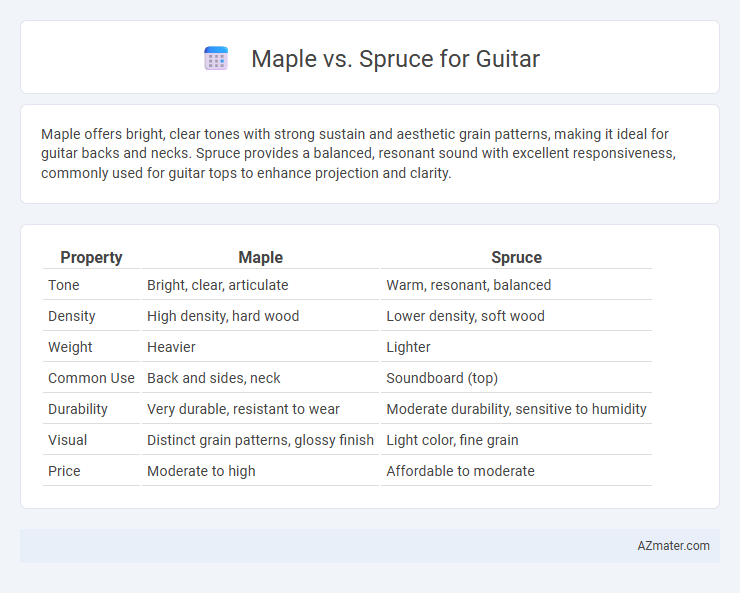Maple offers bright, clear tones with strong sustain and aesthetic grain patterns, making it ideal for guitar backs and necks. Spruce provides a balanced, resonant sound with excellent responsiveness, commonly used for guitar tops to enhance projection and clarity.
Table of Comparison
| Property | Maple | Spruce |
|---|---|---|
| Tone | Bright, clear, articulate | Warm, resonant, balanced |
| Density | High density, hard wood | Lower density, soft wood |
| Weight | Heavier | Lighter |
| Common Use | Back and sides, neck | Soundboard (top) |
| Durability | Very durable, resistant to wear | Moderate durability, sensitive to humidity |
| Visual | Distinct grain patterns, glossy finish | Light color, fine grain |
| Price | Moderate to high | Affordable to moderate |
Introduction to Maple and Spruce in Guitar Construction
Maple and spruce are two of the most popular tonewoods used in guitar construction, each offering distinct sonic characteristics. Maple, known for its dense, hard grain, provides bright, clear tones with strong sustain and excellent projection, often favored for back and sides on acoustic and electric guitars. Spruce, characterized by its lightweight and resonant qualities, is primarily chosen for guitar tops due to its superior responsiveness and balanced tonal clarity, enhancing both volume and dynamic range.
Botanical Origins and Wood Characteristics
Maple, derived primarily from the Acer genus, features a dense, fine-grained structure that enhances brightness and sustain in guitars, favored for necks and backs. Spruce, from the Picea genus, is distinguished by its straight grain and lightweight properties, delivering superior resonance and a clear, dynamic tone ideal for guitar tops. Both woods reflect their botanical origins in tonal clarity and durability, influencing the guitar's acoustic performance and aesthetic appeal.
Tonal Differences: Maple vs Spruce
Maple offers a bright, clear tone with strong midrange emphasis and articulate note separation, making it ideal for players seeking a punchy sound with excellent projection. Spruce delivers a balanced tonal spectrum with pronounced warmth and dynamic response, providing versatility across various playing styles. The tonal difference lies in maple's crisp, focused sound versus spruce's richer, full-bodied resonance.
Visual Aesthetics and Grain Patterns
Maple guitars boast a bright, light-colored tonewood with a smooth, often curly or flamed grain pattern that enhances visual appeal and reflects high craftsmanship. Spruce tops, typically lighter in color with a straighter and more uniform grain, emphasize clarity and a classic, understated elegance in guitar design. Distinctive visual aesthetics from maple's pronounced figuring contrast with spruce's subtle, refined grain contribute to individual instrument character and player preference.
Durability and Longevity
Maple offers exceptional durability due to its dense, hard grain, making it highly resistant to dents and scratches, which extends the guitar's lifespan significantly. Spruce, while not as hard, provides a balance of strength and flexibility but may be more prone to wear over time under heavy use. Choosing maple enhances long-term structural integrity, while spruce offers durability with a lighter weight for easier handling.
Impact on Acoustic and Electric Guitars
Maple wood produces a bright, clear tone with strong sustain, making it ideal for electric guitars and acoustic guitars that require articulate note definition and enhanced projection. Spruce, commonly used for acoustic guitar tops, offers a balanced tonal response with warmth and dynamic range, providing rich resonance and responsiveness essential for versatile playing styles. Choosing maple over spruce impacts the guitar's sound by emphasizing clarity and brightness, whereas spruce emphasizes warmth and complexity, shaping the instrument's overall acoustic or electric performance characteristics.
Preferences for Fingerstyle vs Strumming
Maple guitars offer bright, articulate tones with clear note definition, making them ideal for fingerstyle players who need precision and separation in each note. Spruce tops provide a balanced, warm sound with strong projection, favored by strummers who require a fuller, more resonant tone for chords. Fingerstyle guitarists often prefer maple's clarity, while strummers lean toward spruce's dynamic range and richness.
Cost and Availability Comparison
Maple guitars generally come at a higher price point due to the wood's dense grain and bright tonal qualities, which are highly valued in premium and boutique instruments. Spruce, commonly used as a top wood in acoustic guitars, offers a more affordable option with wide availability, making it popular among beginners and mid-range models. Availability of both woods is broad, but spruce is more readily sourced globally, contributing to its cost-effectiveness compared to the more limited and slightly pricier maple.
Notable Guitar Models Featuring Maple or Spruce
The Fender Stratocaster and Gibson Les Paul are iconic guitars featuring maple necks renowned for their bright tone and sustain, while Taylor and Martin acoustic guitars often use spruce tops for their clear, resonant sound. Maple is prized in electric guitars like the PRS Custom 24 for its durability and snappy attack, enhancing playability and tonal definition. Spruce tops, especially Sitka and Adirondack varieties, dominate premium acoustic models such as the Martin D-28 and Taylor 814ce, contributing to dynamic range and balanced projection.
Choosing the Right Wood for Your Playing Style
Maple wood offers bright, clear tones and strong projection, making it ideal for guitarists who favor sharp attack and defined note articulation. Spruce, especially Sitka or Engelmann varieties, provides a balanced, warm sound with rich harmonics, suited for players seeking versatility and dynamic expression in fingerpicking or strumming. Selecting between maple and spruce depends on whether a guitarist prioritizes tonal brightness and sustain (maple) or warmth and responsiveness (spruce) in their playing style.

Infographic: Maple vs Spruce for Guitar
 azmater.com
azmater.com